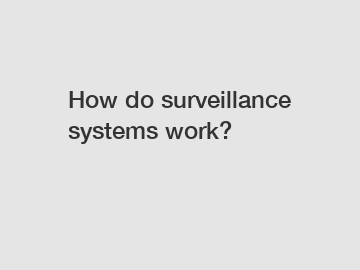How do surveillance systems work?
Surveillance systems have become an essential tool in maintaining security and monitoring activities in various settings, from public spaces to private properties. These systems work by utilizing a combination of technologies to capture, record, and analyze data for the purpose of surveillance. In this article, we will explore the workings of surveillance systems and how they help in enhancing safety and security.
**Types of Surveillance Systems**.
There are several types of surveillance systems, each designed to serve different purposes. Closed-circuit television (CCTV) systems are among the most common types of surveillance systems used today. These systems consist of cameras that capture video footage and transmit it to a centralized monitoring station. CCTV systems can be used for both live monitoring and recording footage for later review.

Another type of surveillance system is the network video recorder (NVR) system, which records video data from IP cameras onto a hard drive. NVR systems offer high-quality video recording and remote access to footage, making them ideal for businesses and homeowners looking to enhance their security measures.
**Key Components of Surveillance Systems**.
Surveillance systems typically consist of several key components, including cameras, recording devices, monitors, and networking equipment. Cameras are the most crucial component of any surveillance system, as they capture the video footage that is used for monitoring and recording activities. Cameras can range from basic fixed cameras to advanced pan-tilt-zoom (PTZ) cameras that can be controlled remotely.
Recording devices, such as digital video recorders (DVRs) and NVRs, store the captured video footage for later review. These devices come with various storage capacities, allowing users to store days or even weeks of footage depending on their needs. Monitors are used to display live video feeds or playback recorded footage, while networking equipment enables remote access to the surveillance system from anywhere with an internet connection.
**How Surveillance Systems Work**.
Surveillance systems work by capturing video footage using cameras, which is then transmitted to recording devices for storage and analysis. Cameras are strategically placed in areas of interest to monitor activities and provide a visual record of events. The surveillance system can be set up for live monitoring by security personnel, or it can be configured to record footage for later review.
Modern surveillance systems often come equipped with motion detection sensors, which trigger the cameras to start recording when motion is detected within their field of view. This feature helps in conserving storage space by only recording relevant events. Additionally, advanced analytics software can be used to analyze video footage for specific objects or behaviors, further enhancing the capabilities of surveillance systems.
**Conclusion**.
Surveillance systems play a vital role in ensuring safety and security in various environments, from public places to private properties. By combining cameras, recording devices, and networking equipment, these systems provide an effective means of monitoring activities and deterring unwanted behavior. Understanding how surveillance systems work is crucial in harnessing their full potential in enhancing security measures.
If you are interested in installing a surveillance system for your home or business, feel free to contact us for expert advice and assistance. Our team of professionals can help you choose the right system to meet your security needs. .
Contact us today for more information!
For more information, please visit led speed signs, radar speed signs, vms display board.


